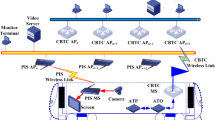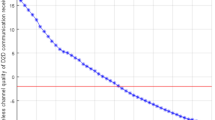Abstract
With recent advances in wireless networks, communication-based train control (CBTC) has become a popular approach to ensure the safe and efficient operation of railway trains. The requirements for train–ground communication in CBTC systems are stringent. Most existing works about train–ground communication systems consider the infrastructure mode without train–train direct communications. Due to unreliable wireless communications and frequent handovers, existing CBTC systems can severely affect train control efficiency and performance, as well as the utility of railway. In this paper, with recent advances in cooperative and cognitive wireless networks, we propose a CBTC system to enable train–train direct communications. In addition, the proposed cooperative and cognitive CBTC system is optimized with the cognitive control method. Unlike the exiting works on cooperative and cognitive wireless networks, in this paper, train control performance in CBTC systems is explicitly used as the performance measure in the design. Reinforcement learning is applied to obtain the optimal handover decision and adaption policy of communication parameters. Simulation result shows that the performance of train control can be improved significantly in our proposed cooperative and cognitive CBTC system.











Similar content being viewed by others
References
IEEE standard for communications-based train control (CBTC) performance and functional requirements. IEEE Std 1474.1-2004 (Revision of IEEE Std 1474.1-1999), pp. 1–45, 2004.
Whitwam, F. (2003). Integration of wireless network technology with signaling in the rail transit industry. Alcatel Telecommunications Review, 1(1), 43–48.
Kuun, E. (2004). Open standards for CBTC and CCTV radio based communication. Technical Forums of Alcatel, 2, 99–108.
Lardennois, R. (2003). Wireless communication for signaling in mass transit. Grenoble, France: Siemens Transportation Systems.
Chung, J.-M., Kim, M., Park, Y.-S., Choi, M., Lee, S., & Oh, H. S. (2011). Time coordinated V2I communications and handover for WAVE networks. IEEE Journal on Selected Areas in Communications, 29, 545–558.
Huang, D.-W., Lin, P., & Gan, C.-H. (2008). Design and performance study for a mobility management mechanism (wmm) using location cache for wireless mesh networks. IEEE Transactions on Mobile Computing, 7(5), 546–556.
Toledo, A. L., & Wang, X. (2006). TCP performance over wireless MIMO channels with ARQ and packet combining. IEEE Transactions on Mobile Computing., 5, 208–223.
Tang, J., & Zhang, X. (2007). Cross-layer resource allocation over wireless relay networks for quality of service provisioning. IEEE Journal on Selected Areas in Communications, 25, 645–657.
Tang, J., & Zhang, X. (2007). Cross-layer modeling for quality of service guarantees over wireless links. IEEE Transactions on Wireless Communications, 6, 4504–4512.
Wei, Y., Yu, F. R., & Song, M. (2010). Distributed optimal relay selection in wireless cooperative networks with finite-state Markov channels. IEEE Transactions on Vehicular Technology, 59, 2149–2158.
Molu, M. M., & Goertz, N. (2014). A comparison of soft-coded and hard-coded relaying. Transactions on Emerging Telecommunications Technologies, 25, 308–319.
Liu, G., Yu, R., Ji, H., Leung, V., & Li, X. (2015). In-band full-duplex relaying: A survey, research issues and challenges. IEEE Communications Surveys & Tutorials, PP(99), 1. doi:10.1109/COMST.2015.2394324.
Dai, M., & Sung, C. W. (2013). Achieving high diversity and multiplexing gains in the asynchronous parallel relay network. Transactions on Emerging Telecommunications Technologies, 24, 232–243.
Woradit, K., Quek, T. Q. S., Suwansantisuk, W., Wymeersch, H., Wuttisittikulkij, L., & Win, M. Z. (2009). Outage behavior of selective relaying schemes. IEEE Transactions on Wireless Communications, 8, 3890–3895.
Ni, W., Shen, G., Jin, S., Fahldieck, T., & Muenzner, R. (2006). Cooperative relay in IEEE 802.16j MMR. Tech. Rep. IEEE C802.16j-06\_006r1, Alcatel. http://ieee802.org/16/relay/contrib/C80216j-06_006r1.pdf
Chong, P. H. J., Adachi, F., Hamalainen, S., & Leung, V. (2007). Technologies in multihop cellular network. IEEE Communications Magazine, 45(9), 64–65.
Haykin, S. (2005). Cognitive radio: Brain-empowered wireless communications. IEEE Journal on Selected Areas in Communications, 23, 201–220.
Haykin, S. (2012). Cognitive dynamic systems: Perception–action cycle. Cambridge: Radio and Radio.
Haykin, S., Fatemi, M., Setoodeh, P., & Xue, Y. (2012). Cognitive control. Proceedings of the IEEE, 100(12), 3156–3169.
Bletsas, A., Lippnian, A., & Reed, D. (2005). A simple distributed method for relay selection in cooperative diversity wireless networks, based on reciprocity and channel measurements. In Proceedings of the IEEE VTC’05-Spring, Stockholm, Sweden.
Kaelbling, L. P., Littman, M. L., & Cassandra, A. R. (1998). Planning and acting in partially observable stochastic domains. Artificial Intelligence, 101(1), 99–134.
Herhold, P., Zimmermann, E., & Fettweis, G. (2004). A simple cooperative extension to wireless relaying. In Proceedings of the International Zurich Seminar on Commication, pp. 36–39.
Zhu, L., Yu, F. R., Ning, B., & Tang, T. (2012). Cross-layer handoff design in MIMO-enabled WLANs for communication-based train control (CBTC) systems. IEEE Journal on Selected Areas in Communications, 30(4), 719–728.
Aquado, M., Jacob, E., Saiz, P., Unzilla, J. J., Hiquero, M. V. & Matias, J. (2005). Railway signaling systems and new trends in wireless data communication. In Proceedings of the IEEE VTC’2005-Fall, Dallas, TX.
Mishra, A., Shin, M., & Arbaugh, W. (2003). An empirical analysis of the IEEE 802.11 MAC layer handoff process. SIGCOMM Computer Communication Review, 33, 93–102.
Yu, F., Wong, V. W., & Leung, V. (2006). Efficient QoS provisioning for adaptive multimedia in mobile communication networks by reinforcement learning. Mobile Networks and Applications, 11(1), 101–110.
Dorato, P., Cerone, V., & Abdallah, C. (1990). Linear-quadratic control: An introduction. New York: Simon & Schuster.
Onat, A., Kita, H., & Nishikawa, Y. (1997). Reinforcement learning of dynamic behavior by using recurrent neural networks. Artificial Life and Robotics, 1(3), 117–121.
Zhu, L., Yu, F. R., & Ning, B. (2010). A seamless handoff scheme for train–ground communication systems in CBTC. In Proceedings of the IEEE VTC’10-Fall, Ottawa, ON, Canada.
Lu, H.-C., & Liao, W. (2012). Cooperative strategies in wireless relay networks. IEEE Journal on Selected Areas in Communications, 30(2), 323–330.
Bletsas, A., Shin, H., & Win, M. Z. (2007). Cooperative communications with outage-optimal opportunistic relaying. IEEE Transactions on Wireless Communications, 6(9), 3450–3460.
Yeh, E. M., & Berry, R. A. (2007). Throughput optimal control of cooperative relay networks. IEEE Transactions on Information Theory, 53(10), 3827–3833.
Ben Letaief, K., & Zhang, W. (2009). Cooperative communications for cognitive radio networks. Proceedings of the IEEE, 97(5), 878–893.
Peng, M., Liu, Y., Wei, D., Wang, W., & Chen, H.-H. (2011). Hierarchical cooperative relay based heterogeneous networks. IEEE Wireless Communication, 18(3), 48–56.
Song, Y., Zhang, C., Fang, Y., & Lin, P. (2012). Revenue maximization in time-varying multi-hop wireless networks: A dynamic pricing approach. IEEE Journal on Selected Areas in Communications, 30(7), 1237–1245.
Acknowledgments
We thank the editor and reviewers for their detailed reviews and constructive comments, which have helped to improve the quality of this paper. This paper is supported by Graduate Student Cultivation Project (352025535) and State Key Lab Project (RCS2015ZT005, RCS2014ZT07).
Author information
Authors and Affiliations
Corresponding author
Rights and permissions
About this article
Cite this article
Li, K., Yu, F.R., Zhu, L. et al. Cooperative and cognitive wireless networks for train control systems. Wireless Netw 21, 2545–2559 (2015). https://doi.org/10.1007/s11276-015-0932-1
Published:
Issue Date:
DOI: https://doi.org/10.1007/s11276-015-0932-1




